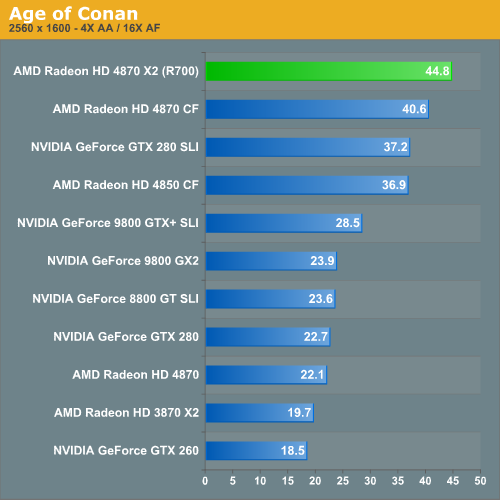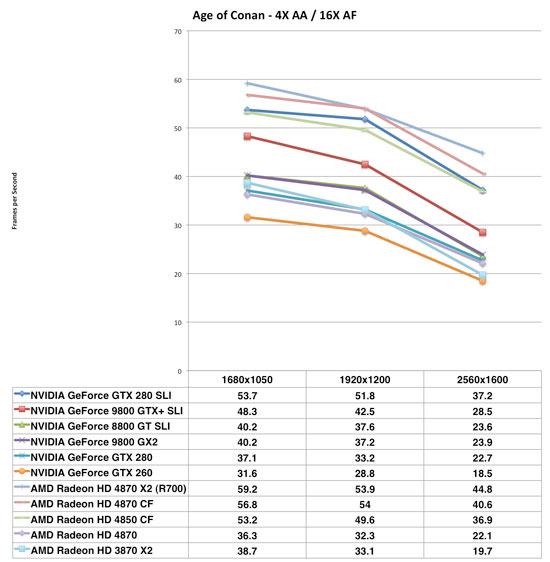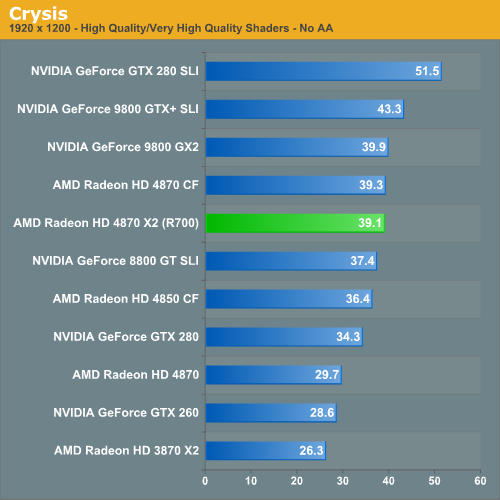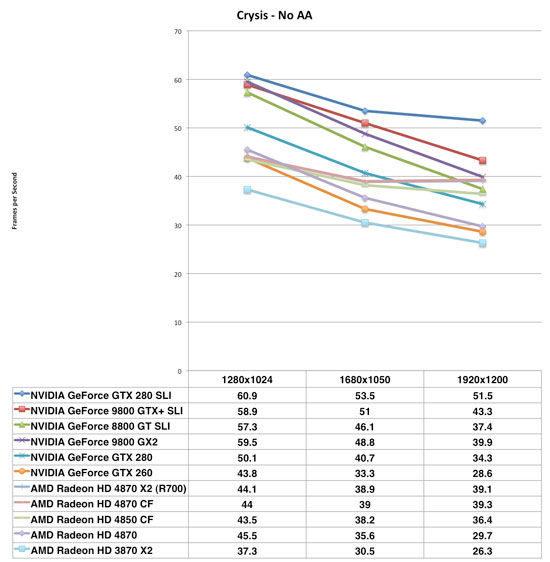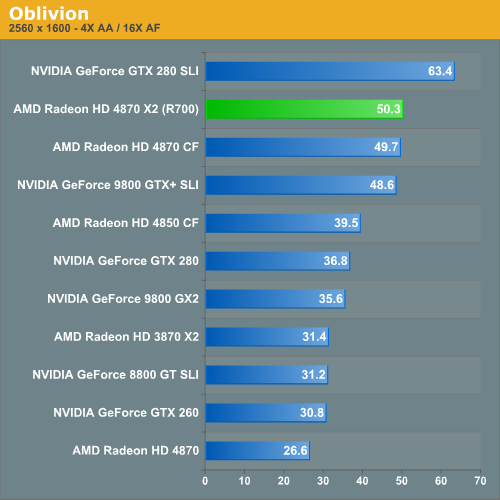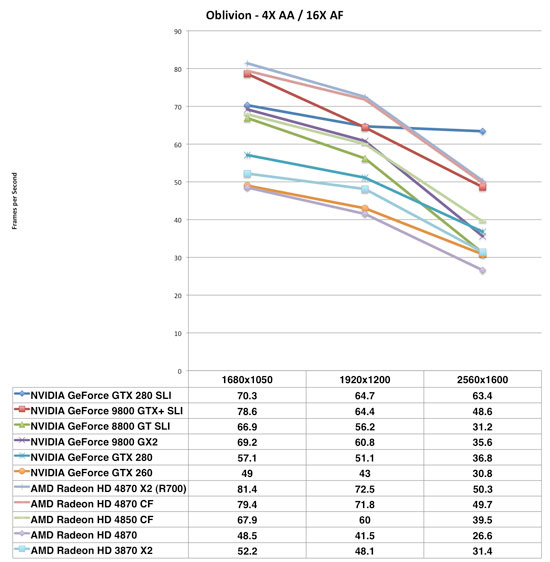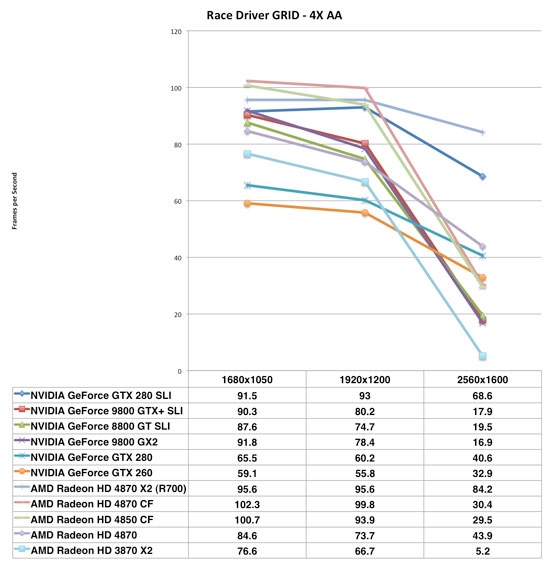
Original Link: https://www.anandtech.com/show/2567
ATI Radeon HD 4870 X2 - R700 Preview: AMD's Fastest Single Card
by Derek Wilson on July 14, 2008 12:00 AM EST- Posted in
- GPUs
Remember this slide?
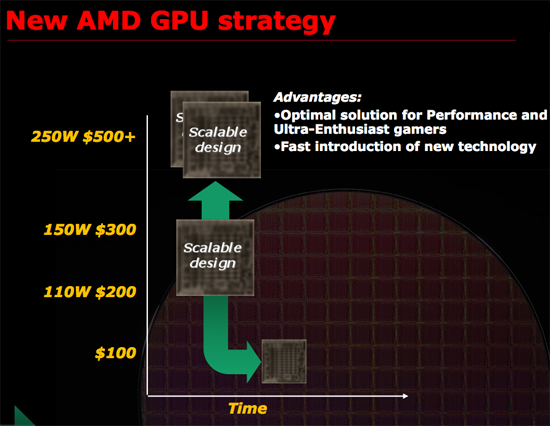
The "Scalable design" block we already know about, that's RV770 - we reviewed it last month. The 150W TDP $300 part is the Radeon HD 4870, and the 110W $200 part is the Radeon HD 4850, the two cards that have caused NVIDIA quite a bit of pain already. The smaller $100 part has a name, and a release date, neither of which we can talk about at this point, but it's coming.
Today however, is about the 250W, $500 multi-GPU solution - internally known as R700. Hot on the heels of the Radeon HD 4800 series launch, AMD shipped out ten R700 cards worldwide, attempting to capitalize on the success of the 4800 and showcase the strength of AMD's small-GPU strategy.
We're assuming that AMD will call the R700 based cards the Radeon HD 4870 X2, and based on the chart above we're expecting them to retail above $500 (possibly $549?). Today's article is merely a preview as R700s won't be officially launched for at least another month, but AMD wanted to unveil a bit of what it's cooking.
| |
ATI R700 | ATI Radeon HD 4870 | ATI Radeon HD 4850 | ATI Radeon HD 3870 |
| Stream Processors | 800 x 2 | 800 | 800 | 320 |
| Texture Units | 40 x 2 | 40 | 40 | 16 |
| ROPs | 16 x 2 | 16 | 16 | 16 |
| Core Clock | 750MHz | 750MHz | 625MHz | 775MHz+ |
| Memory Clock | 900MHz (3600MHz data rate) GDDR5 | 900MHz (3600MHz data rate) GDDR5 | 993MHz (1986MHz data rate) GDDR3 | 1125MHz (2250MHz data rate) GDDR3 |
| Memory Bus Width | 256-bit x 2 | 256-bit | 256-bit | 256-bit |
| Frame Buffer | 1GB x 2 | 512MB | 512MB | 512MB |
| Transistor Count | 956M x 2 | 956M | 956M | 666M |
| Manufacturing Process | TSMC 55nm | TSMC 55nm | TSMC 55nm | TSMC 55nm |
| Price Point | > $500 | $299 | $199 | $199 |
The R700 board is literally made up of two RV770s with a PCI Express switch connecting the two. The clock speeds are identical to the Radeon HD 4870, and memory size per GPU has been doubled to 1GB, which could help in hi res cases with AA enabled. In other words, R700 should perform very much like a pair of 4870s in CrossFire. Or should it?
Building a Better CrossFire
When AMD began talking about no longer building high end hardware using single monolithic GPUs a few weeks back, we let them know that improving CrossFire support would be incredibly important going forward. AMD told us that they are putting a lot into that but also that they have some exciting technology up their sleeves with R700 to help out as well. Unfortunately, we haven't gotten as much detailed information on how it works, but the new technology is GPU to GPU communication.
Until now, CrossFire has done zero GPU to GPU or framebuffer to framebuffer communication. As with the first iteration, each card fully renders the parts of the screen for which it is responsible (be it a whole frame in AFR, the top or bottom half of a screen, or alternating tiles). These results are sent to a combiner where the digital signals are merged and output to the screen. This is the only communication that takes place in CrossFire at the moment. R700 will change that by allowing GPUs to communicate.

RV770 has a CrossFire X Sideport...we assume that the two RV770s on a single R700 board somehow connect Sideports and make fast. AMD hasn't told us how yet.
It is not clear how extensive this communication will be, what information will be shared, or how much bandwidth requirements are increased because of this feature. And while it is a step in the right direction, the holy grail of single-card multi-GPU solutions will be a shared framebuffer. Currently both GPUs need a copy of all textures, geometry, etc., and this is a huge waste of resources. While the R700 has 2GB of RAM on board, it will still be limited in many of the same ways a 1GB RV770 would be as each GPU only has access to half the RAM on the card. Of course, since we don't have a 1GB RV770 yet, this card could show some advantages over the single 4870 regardless of CrossFire.
Regardless of where we want (and need) to see multi-GPU technology get to, R700 is the first part to follow AMD's official change in strategy, and as such it will be very important to establish their place in the market and will need to prove to gamers that they are taking the high end seriously. It's great that single-card multi-GPU solutions are capable of providing high end performance, but when spending the amount of money required to put a high end part in your system, people expect compatibility, reliability, and consistent performance. We can't really talk about how well they pull that off with prerelease hardware and prerelease drivers, but we can't emphasize the importance of this enough. We will certainly be putting the screws to it when the hardware does eventually make it out into the wild.
UPDATE: Our initial publication of this article indicated a 2x 512MB framebuffer for a total of 1GB on board. We have since learned that the R700 we tested has 2GB of RAM total for 2x 1GB framebuffers. This has affected some of our analysis and conclusion. We do apologize for any confusion this may have caused.
The Card
Obviously, this is a large card. But like the 3870 X2, AMD has managed to keep the board fairly compact for having two GPUs and 1GB of GDDR5 on board.

The R700 does have a plate across the back of the card like the 3870 X2, and it also has RAM on the back as well (the 4870 carries all it's RAM up front). These RAM chips are different than what is used on the single 4870, but capacity and performance should be identical.

The R700 needs one 6-pin PCIe power connector and one 8-pin connector
The layout is very clean for the amount of stuff that needs to happen here.
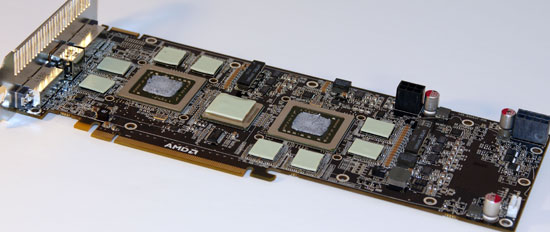
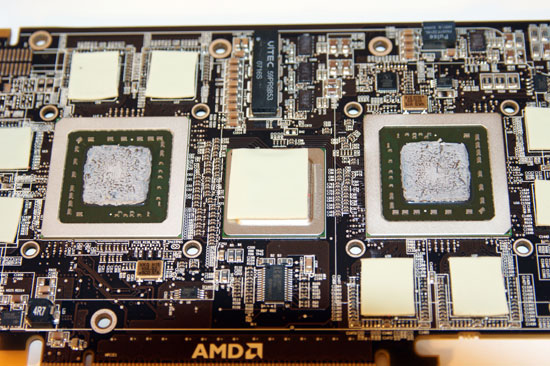

That's a black AMD PCB
Picking The Games
AMD did have some stipulations for our R700 preview, they were as follows:
1. Previews can be posted any time after 12:01 am on Monday, July 14th.
2. Previews can include benchmarks of any combination of artificial tests or games up to a maximum of four.
3. As PowerPlay has not been enabled in the BIOS on your engineering sample, please stay away from Idle Power tests at this point.
4. In the interest of leaving something for the full NDA lift in August, we'd ask you to keep this high level and not go deep on the architecture at this point.
Today is Monday, July 14th, so we met the first requirement. AMD didn't give us much detail on the architecture, so check there as well. PowerPlay hasn't been enabled but it will in the final card, fair enough, we will only test load power. The second point was the tricky one though - AMD only wanted us to test four games, although it was up to us to choose which ones.
Of course, we did take the opportunity to do some internal testing in order to find out what tests were the best to present. For the most part (yes there are exceptions) the R700 performed similarly to what we would expect from 4870 in CrossFire. Therefore, we would refer our readers to our RV770 review for a general idea of what to expect from R700 in the worst case.
AMD has said that they are still improving CrossFire support and performance for many games and this preview driver doesn't necessarily reflect the performance we will see at launch in all games. This puts us in a bit of a tight spot, as reporting numbers for the games that currently don't benefit (or don't benefit much) from R700 over 4870 could be attributed to the prerelease driver. This very fact limits our ability to fairly report on the potential downside of R700.
In light of that, to make the best of this limited preview, we feel that we both have to report on games that do benefit from CrossFire and underline the fact that there are games out there that do not benefit or that do not benefit significantly from CrossFire (or SLI or multiGPU in general). At launch, we will try to do a much better job of representing the potential downside: we are currently asking our readers and our forum members for feedback on what games they play or know of that do not benefit from multiGPU so that we can take a look at them and help fairly represent the downside of any multiGPU solution. Please help us out if you have the information or the time to do so.
Looking at games that benefit from CrossFire or that benefit differently with R700 than a multi-card solution, we decided that it wouldn't be any fun just to show what we've seen over and over in our reviews. We can't avoid Crysis, so that will be included. Oblivion has been a good standby that can still bring cards to their knees at the highest settings. But before we had even contemplated this preview we've been looking at adding a couple new games to our test suite.
We always get requests for MMOs, and Age of Conan is the new hotness. Even though the DX10 version isn't out in the wild yet, we developed a repeatable benchmark for this game and will be using it in this preview. Additionally, flying and racing games are often requested. We won't be adding flight sim in this round, but Race Driver GRID is an incredibly beautiful game that we are happy to add to our test suite.
Again, as we mentioned, R700 does perform similarly to CrossFire, so looking at past 4870 CrossFire results is a fair indication of performance.
The Test
Most of our numbers come from our recent RV770 review. For the new games we've added, we used the latest drivers available for all the cards. The beta drivers we have for R700 were used for all AMD parts in Age of Conan and Race Driver GRID.
| Test Setup | |
| CPU | Intel Core 2 Extreme QX9770 @ 3.20GHz |
| Motherboard | EVGA nForce 790i SLI Intel DX48BT2 |
| Video Cards | ATI Radeon HD 4850 ATI Radeon HD 3870 X2 ATI Radeon HD 3870 EVGA GeForce 9800 GTX KO NVIDIA GeForce 9800 GTX+ NVIDIA GeForce 9800 GTX NVIDIA GeForce 9800 GX2 NVIDIA GeForce 8800 GTX NVIDIA GeForce 8800 GT NVIDIA GeForce GTX 280 NVIDIA GeForce GTX 260 |
| Video Drivers | Catalyst Press Driver (8.7 beta) Catalyst 8.5 ForceWare 177.34 (for GT200) ForceWare 177.39 (for 9800 GTX/9800 GTX+) ForceWare 175.16 (everything else) |
| Hard Drive | Seagate 7200.9 120GB 8MB 7200RPM |
| RAM | 4 x 1GB Corsair DDR3-1333 7-7-7-20 |
| Operating System | Windows Vista Ultimate 64-bit SP1 |
| PSU | PC Power & Cooling Turbo Cool 1200W |
Age of Conan Performance
Age of Conan is a nice looking MMO that will soon have a DX10 path. For now, we tested everything on the highest settings except AA (set to 4x), and we enabled the advanced transparency option (which we assume is an in-game option for transparency AA, though we could be wrong).
Clearly, AMD is king in Age of Conan, with the single card performing well and terrific CrossFire scaling as well. The 4870 X2 will be quite fast here, at least in the DX9 path.
The R700 did perform a bit better here and there than multi-card Crossfire, but nothing to write home about. In general, performance between the two is very similar. And of course, if this performance holds until launch, AMD's R700 will be worth a nice premium over a single GTX 280.
Crysis Performance
Simply because it is Crysis, we must take a look at performance. And in this case, R700 performed right on point with 4870 in CrossFire.
Unfortunately, CrossFire leaves a lot to be desired in terms of multi-GPU performance scaling under Crysis. SLI scales much better, but the fact that R700 performs identically to 4870 in CrossFire means that it is at least significantly faster than a single GTX 280. Which isn't shabby.
The Elder Scrolls IV: Oblivion Performance
Here we see the same thing we saw in our look at 4870 and 4870 -- R700 and CrossFire perform nearly identically with the 4870 X2 having a very slight advantage.
All in all, this is fairly representative of what we saw with the card. Comparing with our previous article, R700 scales very similarly to 4870 in CrossFire. Oblivion is really no different, but we did want to show one game that isn't Crysis to back this up. Here it is. :-)
Race Driver GRID Performance
This is by far the most interesting test we have numbers for today.
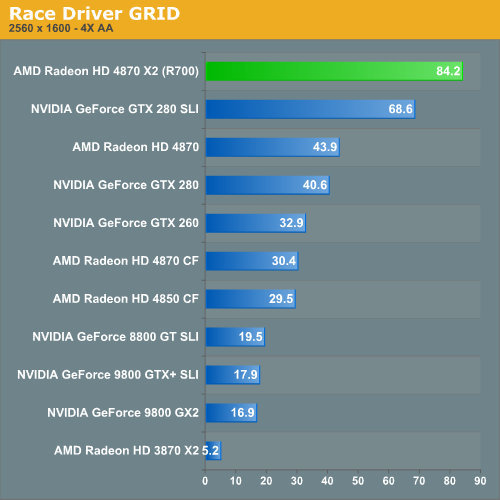
Here we see at 2560x1600, where all of our multi-GPU solutions struggled to get through the menus and into the game, our 4870 X2 shows a performance increase that illustrates good scaling. It is likely that the extra 512MB of RAM available to each GPU has significantly impacted perforamnce since we are testing with all the options cranked up and 4xAA. It may be possible that the R700 hardware offers tangible advantages over AMD's previous method of performing CrossFire, but we can't know if this could be the case with the memory difference being such a likely culprit here.
It does make sense, on a high end part, to target an audience that will be pushing memory limits as far as possible. While gamers who want a single 4870 might not want to run at 2560x1600, it really doens't make much sense right now to go with a hugely expensive card unless you want that kind of resolution. This does add an advantage for R700 over two card crossfire at the moment (which may or may not go away after the introduction of 1GB 4870 cards).
Beyond that, we do note that in addition to our other added game, GRID shows a clear advantage over GT200 for AMD's latest generation.
Power Heat and Noise
This is prerelease hardware and software, so we can't really go in depth on these issues until we have something more final. We were told that idle power is not what it will be and so not to test it at all. We did, however look at load power.

As for heat, this card doesn't get any hotter to the touch than a single 4870. The HSF is much heavier than either 4870 or 3870 X2, and is very likely the reason the heat doesn't stay in the system.

Hot surface
On the noise front, when gaming it does spin up, but it isn't any louder than the GTX 280 at max fan speed. Again, we'll want to wait until we have final hardware to do quantitative tests on this, but it is nice to see that even the prerelease hardware doesn't go crazy in terms of heat and noise.
Final Words
The two new additions to the test suite, Age of Conan and Race Driver GRID certainly beef up the portfolio of advantages AMD has in the current generation. Not only that, but we got quite an interesting surprise with GRID. Yes, even with R700 the menu screens were slow, jerky and painful at 2560x1600, but gameplay with R700 was much improved. We will still see the upper limit at twice the performance of a single RV770, but the fact that R700 looks to offer at least the potential for much better scaling at the high end (where the card will be marketed) than two card solutions is an advantage, even if it only comes from the additional RAM. We will need to look at CrossFire again when the 1GB 4870 is available to get a more apples to apples comparison here.
We don't have any solid evidence in this article of the GPU to GPU communication hardware making a real difference in scaling, but we will be interested to see if that changes by the time R700 hits store shelves. We can say that, for those who want to game at the extremely high end, 4870 X2 with it's 2GB of on board RAM will be a more consistent solution than 2x 512MB 4870 cards in CrossFire, as evidenced by our Race Driver GRID test.
But as we've said many times before, the success of CrossFire is in the consistency of it's performance. We absolutely need to see AMD put everything they have into making all games past, present, and future scale well with CrossFire. There needs to not be even the inkling of a question that CrossFire might not improve the performance of a game. Until then it is very risky for AMD to put all of its hope for the high end business into a multi-GPU solution.
Maybe they've done it. Maybe their driver team, by the time 4870 X2 launches will have improved driver support to where it needs to be. Maybe the changes to the R700 hardware will be enough to fill in the gaps and bring performance up closer to the theoretical limit for many more games. The information we have here shows the incredible potential R700 has, but it will be absolutely necessary to wait until launch day to see if the execution behind the hardware has been enough to realize this potential across the board.
This isn't a case where the quality of the hardware, but rather the quality of the driver and programming style of modern game developers will be key in delivering value. For the launch of this card we will be looking at as large a cross section of games as we can, as the importance of broad testing has never been more clear than with AMD's first part after their declared strategy of using single card multi-GPU solutions to compete in the high end space. We will need to see more examples of improved single card multi-GPU performance over CrossFire, as well as improvements in CrossFire performance in general if AMD is to be taken seriously going forward in the high end space.
The 4870 X2 will be AMD's proving ground. This preview shows what might be, what could be ... but we must wait for final hardware and final drivers before we can honestly evaluate the card for what it is. Let us hope AMD knows how important having pervasive compatibility really is for this launch.







